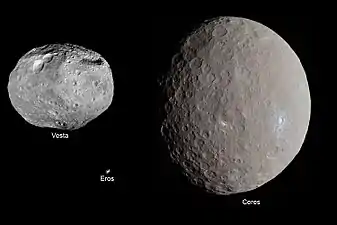Janus (spacecraft)
Janus is a planned dual space probe that will visit two binary asteroids, (175706) 1996 FG3 and (35107) 1991 VH. The mission is expected to be launched in August 2022 as a secondary payload on Falcon Heavy together with the Psyche space probe,[1] and to arrive at the two binary asteroids in 2026. On 3 September 2020, Janus successfully passed Key Decision Point-C and was approved for the final design of hardware. The mission budget is limited by US$55 million.[2]
| Mission type | Asteroids flyby | ||||||
|---|---|---|---|---|---|---|---|
| Operator | University of Colorado Boulder, NASA | ||||||
| Mission duration | 4 years (planned) | ||||||
| Spacecraft properties | |||||||
| Spacecraft | Janus | ||||||
| Manufacturer | Lockheed Martin | ||||||
| Launch mass | 180 kg | ||||||
| Power | 2 solar arrays and batteries [1] | ||||||
| Start of mission | |||||||
| Launch date | August 2022 | ||||||
| Rocket | Falcon Heavy [1] | ||||||
| Launch site | Kennedy Space Center, LC-39A | ||||||
| Contractor | SpaceX | ||||||
| End of mission | |||||||
| Last contact | |||||||
| Flyby of Earth | |||||||
| Closest approach | 2023 | ||||||
| Flyby of (175706) 1996 FG3 | |||||||
| Closest approach | 2026 | ||||||
| Flyby of (35107) 1991 VH | |||||||
| Closest approach | 2026 | ||||||
| |||||||
Small Innovative Missions for Planetary Exploration (SIMPLEx) Program | |||||||
Spacecraft
Using small spacecraft -- less than 180 kilograms in mass -- SIMPLEx selections will conduct stand-alone planetary science missions. Each will share their ride to space with either another NASA mission or a commercial launch opportunity. The spacecraft is jointly developed by two teams, based at the University of Colorado Boulder (lead by Daniel Scheeres) and at Lockheed Martin (head by Josh Wood).
Instruments
The Janus team plans to image the two binary asteroid systems, mainly in visible and infrared light, using the ECAM-M50 (visible) and ECAM-IR3a (infrared) cameras, which have been developed by Malin Space Science Systems successfully used on the OSIRIS-REx space mission.[3]
Mission
A small satellite mission that will study the formation and evolutionary implications for small "rubble pile" asteroids has received NASA approval to proceed to the next phase of its development.[2] Janus is managed by the Planetary Missions Program Office at NASA's Marshall Space Flight Center in Huntsville, Alabama, as part of the Solar System Exploration Program at NASA Headquarters in Washington, D.C.. The program conducts space science investigations in the Planetary Science Division of NASA's Science Mission Directorate at NASA Headquarters, guided by NASA's agency priorities and the Decadal Survey process of the National Academy of Sciences. Janus is led by the University of Colorado Boulder, where the principal investigator (PI) is based, which will also undertake the scientific analysis for the mission. Lockheed Martin will manage, build and operate the spacecraft. After riding along with the launch of NASA's Psyche mission in August 2022, the Janus twins will first complete an orbit around the Sun, before heading back toward Earth for a gravity assisted sling-shot far into space and beyond the orbit of Mars.[2]
References
- Janus A, B (SIMPLEx 3) at Gunter's Space Page
- "New SIMPLEx Mission to Send SmallSats on Longest Deep Space Journey to Date". NASA. 10 September 2020. Retrieved 1 January 2021.
 This article incorporates text from this source, which is in the public domain.
This article incorporates text from this source, which is in the public domain. - NASA's Janus Mission is Going to Visit Two Binary Asteroids at Universe Today
External links
- New SIMPLEx Mission to Send SmallSats on Longest Deep Space Journey to Date at NASA
- NASA's Janus Mission is Going to Visit Two Binary Asteroids at Universe Today
- Janus: A mission concept to explore two NEO Binary Asteroids by D. J. Scheeres et at.
- Where no spacecraft has gone before: A close encounter with binary asteroids by Daniel Strain at CU Boulder Today




